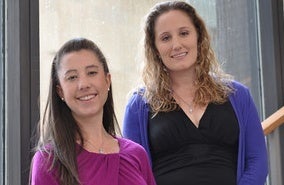March 30, 2012
Chagas disease affects an estimated 8 to 11 million people worldwide. Caused by a parasite transmitted primarily through a bite from the triatomine, or “kissing” bug—so-called because it frequently bites humans on the face—Chagas has two stages, one acute and one chronic, that are difficult to cure. In the short term, it can cause swelling and mild, flu-like symptoms. Over the long term, it can result in gastrointestinal disease and heart failure that can lead to death.
But because Chagas affects mostly the poor in Central and South America as well as immigrant populations in the U.S., it is one of the world’s most neglected diseases. Many people haven’t even heard of it.
Now, two Harvard School of Public Health (HSPH) graduate students are hoping to help move Chagas disease squarely onto the world’s radar screen. Jennifer Manne, a doctoral candidate in the Department of Global Health and Population, and Callae Snively, a master’s candidate in the Department of Health Policy and Management, have been examining a host of Chagas-related issues—such as how best to control the bugs that transmit the disease and how to ensure patients can access available medicines.
Killing the bugs, studying the drug supply chain
The students’ research has recently been published in two journals. In an article in the March 2012 issue of the American Journal of Tropical Medicine and Hygiene, Manne—with senior author Marcia Castro, assistant professor of demography at HSPH, and colleagues—analyzed the effectiveness of recent attempts in Guatemala to control the triatomine bug. And an article in the March 2012 issue of Lancet Infectious Diseases, also by Manne—as well as Snively, senior author Michael Reich, Taro Takemi Professor of International Health Policy at HSPH, and others—highlighted supply chain problems with Chagas disease medicines.
In the first article, which examined a Guatemalan program of house spraying with insecticides to kill the triatomine bugs, Manne and her colleagues calculated that it’s best to spray, at minimum, once a year—every six months is even better—to stop reinfestation. They also found that spraying efforts should be particularly targeted to reinfestation hotspots.
In the second article, Manne, Snively, and their co-authors discussed problems in ensuring adequate global supplies of the two medicines available to treat Chagas—benznidazole and nifurtimox. The authors say it’s possible that donated supplies of nifurtimox have reduced the willingness to pay for benznidazole, which can in turn affect supply. In addition, a lack of public treatment data makes it difficult to estimate consumption of Chagas medicines, which in turn makes it hard to predict overall demand, say the authors. Therefore, it’s important to develop accurate market analysis and demand forecasting, taking into account both medicines, to ensure a consistent supply.
Manne and Snively also advocate for the creation of a Chagas disease alliance to help develop solutions for supply chain problems and improve strategies for fighting the disease.
A complex disease
There are a host of other Chagas-related issues, the HSPH students say. Sometimes the disease is difficult to diagnose, particularly in its chronic phase, when the parasite that causes it is nearly undetectable. Sometimes doctors are reluctant to diagnose or treat patients with Chagas if treatment isn’t readily available. Also, there may be unwillingness to prescribe or take Chagas medications because of possible adverse side effects.
All of these challenges conspire to create a “vicious cycle,” Manne says. Snively says studying Chagas disease has been “like going down a rabbit hole. You think you get to the bottom of one issue, but then another one pops up.”
But both students say the myriad issues surrounding prevention and treatment for Chagas disease—regulatory, clinical, logistical, and political—fuel their determination to provide the public health evidence necessary to fight it. Says Snively, “We want to push academic dialogue to create solutions.”
Manne thinks she and Snively are studying the disease at an opportune moment, given the recently formed partnership, Uniting to Combat Neglected Tropical Diseases. Funded by the Gates Foundation, the World Bank, and a number of governments, global health organizations, and pharmaceutical companies, the $785 million initiative includes Chagas on its top-ten list of neglected diseases.
“There’s not a lot of information yet on exactly what the strategies will be to fight this disease,” she says. “We hope that some of our academic work will help shape the agenda.”
–Karen Feldscher
photo: Aubrey LaMedica
